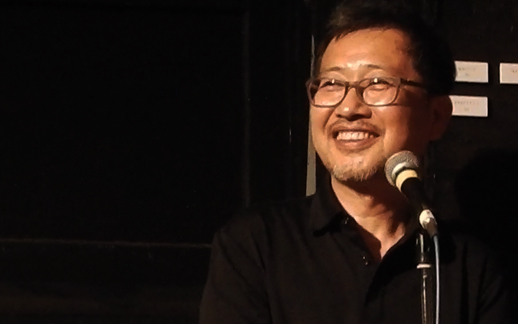Historic Misgivings – East Asian Yasukunism
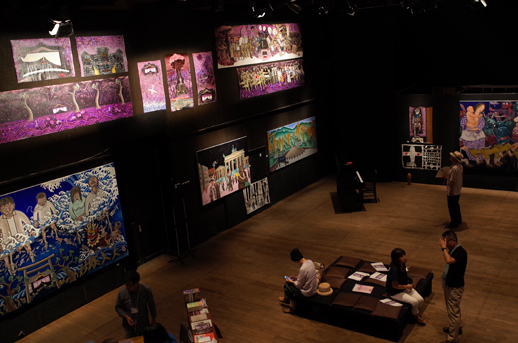
As Japan and the world face the heavy task of marking 70 years since the end of WWII, major public museums spotlight representations of conflict through art both in critique and support of war. Works by artists such as Toraji Ishikawa, Kenichi Nakamura, and Saburo Miyamoto (including Miyamoto’s “The Meeting of General Yamashita and General Percival”) give glimpses of hard-lining war propaganda as well as searing condemnations of the suffering brought by warfare. Given the current climate, we can imagine most of these exhibits will play it safe and keep controversy at arm’s length, yet there is one which pointedly refuses to do so: “East Asian Yasukunism”, which runs this week only through August 2nd at Burehito no Shibakoya Theater in Musashiseki, Tokyo. With its title already ringing alarm bells, “Yasukunism” takes as its subject the aestheticization of war and death in the very form of Yasukuni Shrine. The show’s collection is centered on the work of Sungdam Hong and the collages of Nobuyuki Oura, stridently confronting a historical debate from which others might shy.

Yasukuni has been a point of contention throughout post-war history. Enshrining all those who died for the “Empire”, including Class A war criminals, the annual visits of prime ministers and government officials cause frequent uproars in China and Korea. There is no greater symbol of the aestheticization of death in the name of the imperial realm and the consequent exploitation of Asian people, as the shrine comes to glorify and beatify loss for the nation. Misunderstandings surrounding the shrine are rife, with many seeing it as a symbol of Japanese tradition, when it was in fact created in 1869 to mark the victory of imperialists in the Boshin War and the establishment of the Meiji government. Yasukuni can be considered a vehicle of Japanese colonialism and militarization, encapsulated in a myth in which the word “Eirei” (the spirits of dead soldiers) seems to ring with the appeal of centuries of sacrifice for one’s country, when the term is actually a modern invention emerging after the Russo-Japanese War. For some, Yasukuni is the ultimate embodiment of the fallacies of history or the elusive nature of historical truth.
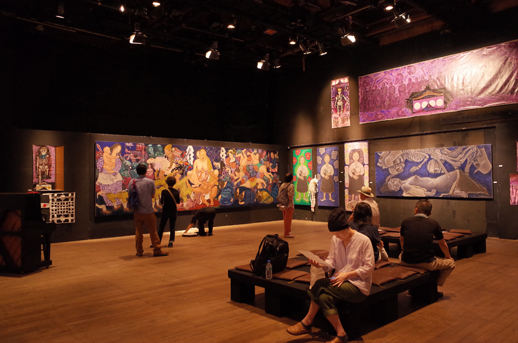
Political philosopher Akira Maeda comments in a text accompanying the exhibition that the resurgence of military spirit in Japan today is surely a symptom of “Yasukunism”. With the current government set to pass a radical reworking of the pacifist constitution in the form of the security bill, curator and Korean culture specialist Mika Furukawa agrees that Yasukuni has come to reflect the current embroilments of Japanese politics and society. As the show’s title suggests and Furukawa reiterates, however, “Yasukunism” is not merely a problem of Japan–nationalism, state violence, historic misinterpretations and the will to war are issues witnessed throughout East Asia and around the globe. This state of affairs is the true target of “East Asian Yasukunism”.
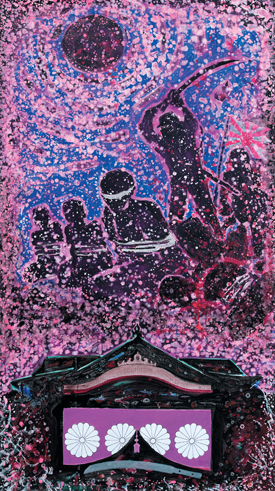
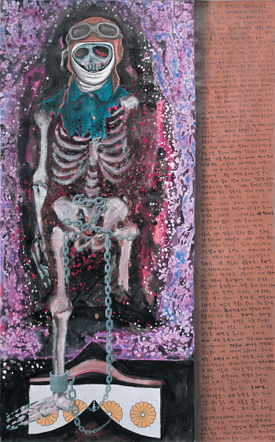
Sungdam Hong, star of the exhibition, is no stranger to political controversy, having previously been imprisoned in the 1980’s for his highly visible role in the democracy movement. In 2014, the legendary artist of the Minjung (people’s) cultural movement was invited to exhibit at the Gwangju Bienniale, hosted by the city where 24 years earlier he had participated in the mass uprising against the government’s military dictatorship – an event in which over 600 people lost their lives in skirmishes between demonstrators and government troops. With South Korea still reeling from the tragic Sewol ferry disaster that drowned 300 passengers, mainly high school children, the Biennial Hong unveiled a bitingly satirical mural of immense proportions under the title “Sewol Owol”.
This 10-meter long painting depicted in no uncertain terms the discontent towards Park Geun-hye’s government and its failures in the rescue operation, while hinting at the current state’s repressive regime through the image of Park’s father (the former martial-law president Park Chung-hee) and the presiding Chief of Staff. The entire scene of the work is set against a backdrop of wailing figures being tossed to their deaths by the merciless waves. As Hong lifted the curtain upon this colossal work, the Gwangju City government was brought to much disquiet, resulting in a request for the work’s removal. Ultimately the Biennial Foundation resolved to postpone the painting’s exhibition until a public debate could take place, but Hong decided to remove the work in protest.
This incident sent shock waves through the art world at the appearance of alleged censorship, leading Biennial director Lee Yong-woo to resign in objection to the city’s actions. Several artists, including Lee Yun-yop, Jeong Young-chang and a group from Okinawa, boycotted the international art festival. Other artists reacted by incorporating statements of protest into their works, among them Japan’s Nobuyuki Oura, who added to his collaged images blunt comments in Japanese, Korean and English rejecting censorship and resisting suggestions by organizers that this would obstruct the reception of his work. Here in “East Asian Yasukunism”, this solidarity is consolidated as Oura’s work is shown alongside Hong’s, and Oura goes even a step further in his critique by presenting large burnt portions of his work incinerated in an obliteration of image and information.
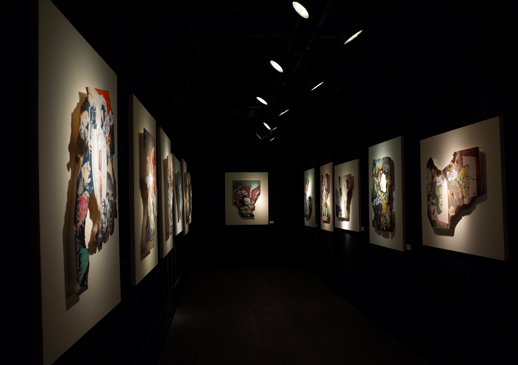
As recent events in Japan have also shown, issues of over-sensitivity regarding political (or sexual) content in artworks have led to various alterations, police investigations and removals, and in the case of artist Rokudenashiko legal court cases, clearly demonstrating that the incident of Gwangju Biennial is not a one off, nor restricted to South Korea. Given this atmosphere, it seems all the more surprising that an exhibition of work from Sungdam Hong has been realized in Japan, especially under such a controversy-courting title.
Set within the lofty hall of the Burehito no Shibakoya Theater, Sungdam Hong here gathers together 10 years of work in the ongoing series “Yasukuni Fallacy”, with close to 30 impressively scaled paintings covering all available wall space with their unflinching depictions of terror. Speaking to Tokyo Art Beat, Sungdam Hong expressed his feeling of familiarity with the chosen space, having been heavily involved in theater as a child and young adult. The theater space is a perfect location in which to enact this “Fallacy”. His large panels become the staging and we the viewers become the actors, having to play out a story or determine our next move in this narrative. Yet here we not only meet the theatrical space of the performing arts, but also the sacred spaces of worship, the scale of the venue and the composition of works upon its walls echoing that of a church or shrine, a place in which one finds the enactment of ritual and the power of belief, imagery highly apt for a dissection of faith in the nation and faith in history.
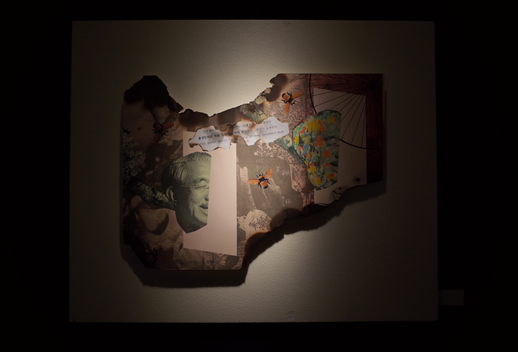
There is little room for subtlety in “Yasukuni Fallacy”. Hong’s paintings are uncompromisingly direct, as seen in a central image presented like a religious icon that shows the Showa emperor in his traditional regalia while the nuclear cloud of Hiroshima and Nagasaki rise up behind him. There are also chaotically violent scenes of rape and pillage. Hong’s message is clear, and to some the sheer force of this outcry may be difficult to digest, but his works are not merely a tirade against Japanese nationalism and the politics of the day, but also a wider blast upon dominant world powers and our own responsibility as actors within these power networks.
As the exhibition’s curators point out, though, we are all caught in “Yasukunism”. This exhibition asks of us–What do we enshrine, what do we choose to ignore, and in what apparatuses of state do we find ourselves caught in everyday life?
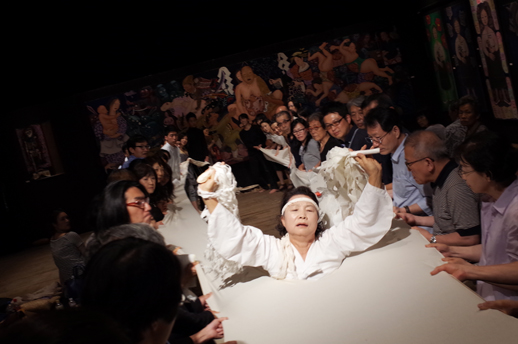
Exhibition Details:
East Asian Yasukunism
Sungdam Hong “The Yasukuni Fallacy”
July 25(Sat)-August 2(Sun)
Weekdays: 13:00-19:00, Weekends: 12:00-19:00
Venue: Burehito no Shibakoya
6mins walk from Musashiseki Station on the Seibu Shinjuku Line
TEL: 03-3920-5232 http://www.tee.co.jp
Admission: 1000 yen, Students/Exemptions 500 yen, High School Students and below free (Valid only for one day)
Event Admission: Adults 1500 yen, Students/Exemptions 1000 yen,
■Enquiries: damten518@gmail.com TEL: 080-3731-1075
https://www.facebook.com/damten518
Yasukunism is a phrase coined by Douglas Lummis (Professor of Okinawa International University) in an ironic comparison of the romanticism spun around Yasukuni by Japanese conservatism and German Nazism. Put in other words this might be referred to the nationalism and nationalist violence which lies within our everyday lives.
At this very time it is not only Japan but also across East Asia that this form of “Yasukunism” appears to be taking a new stride. And we must view this in light of post-3.11 Japan, the Fukushima disaster and the military base issues of Okinawa.
This summer a challenging exhibition takes on the aestheticism of Yasukunism through a critical eye. Centering around the impressively scaled work of Korean artist Sungdam Hong’s series “Yasukuni Delusions”, produced over a period of 10 years, combined with talks, poetry readings, performance, film screenings, this exhibition tackles the historical issues of “Yasukunism” in East Asia. Through the combination of art and activism a strength may be born to rival that of Yasukuni historicism and bring about a new sense of shared East Asian historicity.
Related Events
July 29(Wed) 19:00-21:00 Yasukuni and Contemporary Japanese Society/The Emperor System // Speakers: Shintaro Nakanishi + Satoshi Ukai
July 30(Thurs) 19:00-21:00 East Asian National Violence and Yasukunism // Speakers: Wan Mo-lin, Soh Sun, Sungdam Hong
July 31(Fri) Art and Yasukunism // Speakers: Yoshitaka Mori, Daisuke Inoguchi, Kentaro Ichihara, Minoru Kinjo, Sungdam Hong
August 1(Sat) 14:00-17:00 Yasukuni and the Japanese Military “Comfort Women” – Living with Memory Screening + Talk: Toshikuni Doi + Sungdam Hong
August 2(Sun) 14:00-17:00 East Asian Yasukunism // Speakers: Douglas Lummis + Yuuko Tanaka
Part of this exhibition will tour to Maruki Gallery for the Hiroshima Panels in August
Dates: August 5(Wed)-August 30(Sun) 09:00-17:00 Closed on Mondays
August 11(Tues) 14:00- Talk: Sungdam Hong x Yukinori Okamura
Admission: Adults 900 yen, High School and Junior High School Students 600 yen, Elementary Students 400 yen, visitors with a disability certificate half price
http://www.aya.or.jp/~marukimsn/
Address: 1401 Shimokarako, Higashimatsuyama-shi, Saitama 355-0076
Sungdam Hong
Born in 1955 in Jeolla province, Korea. 1980 participated in the Gwangju uprising against Chun Doo-hwan’s military dictatorship and went on to became a central figure of Minjung (“people’s”) cultural movement. 1987 imprisoned for 3 years on charges of collaborating with North Korea for creating a mural critical of the South Korean government. 2005 Began the ongoing series “Yasukuni Fallacy” . 2007 showcased his first solo exhibition in Japan at Gallery Maki. 2014 Hi epic mural “Sewol Owol” was removed from Gwangju Biennale for being “too directly political”. 2015 April invited to join the exhibition “Banned Images – Control and Censorship in East Asian Democracies” in Berlin, Germany.
Also Worth a Look
MOMAT Collection: What are You Fighting For? Until September 13
MOT Collection: Postwar Art in Close-Up Until October 12
Emma Ota
Emma Ota




